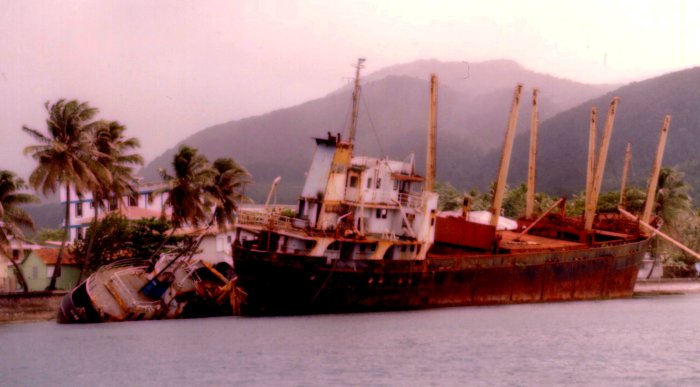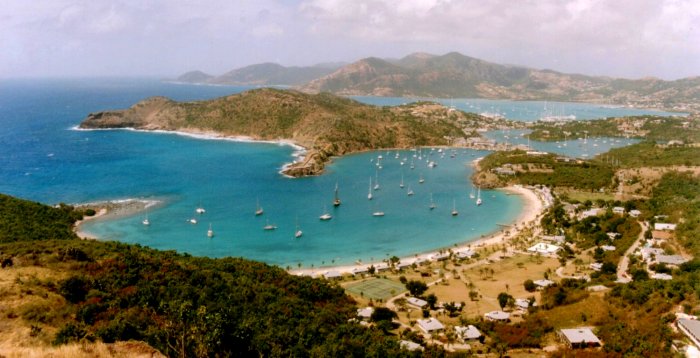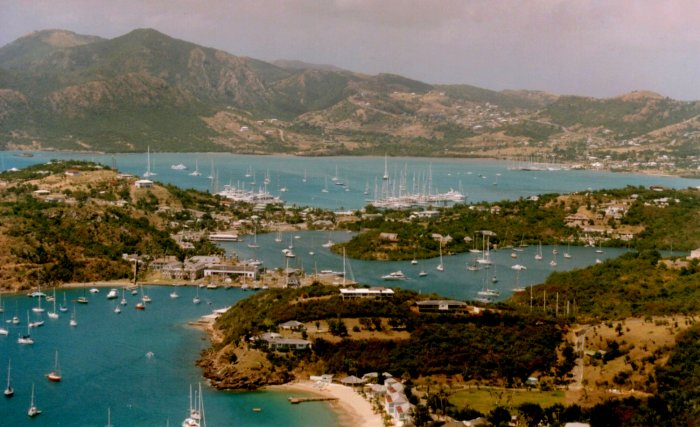(7,165 Statute miles ; 12,897 km)
Since leaving Union Island in the southern Grenadines on 28th December, we have explored all the islands to the north as far as Barbuda. This brings the major island count since arriving in the Caribbean to twelve. They have almost all been markedly different physically, socially and economically. Every day brings it's crop of new experiences with something to learn. We make new friends and meet up with old ones at an amazing rate. All of which makes 'living the dream' even more enjoyable than we had ever imagined.
Dominica proved to be a magic island of lush rain forest and teaming wildlife. However it is very poor, having also very limited sheltered anchorages. We managed to see much of the island, bathing under huge waterfalls, rowing up narrow rivers, exploring rain forests as well as marvelling at the extensive and superbly restored fortifications bequeathed by the British at Cabrits on the north side of Prince Rupert Bay (Admiral Rodney's stomping ground).
The waterfront of the town of Portsmouth in Prince Rupert Bay has a fleet of over twenty boats, aground from the numerous hurricanes that have hit the island over the past years. Here are just a couple, double parked in the back yard of the local police station. The place is so poor that it seems they may well remain there until they rust away.

Dave has now managed to get back into scuba diving again seriously, as a number of the cruisers we come across also dive, so there are plenty of partners. The most interesting dives have been on wrecks. Off St Pierre, on Martinique, a large number of boats were sunk in May 1902. Mount Pelée, the local volcano sent gas at over 2000°c down through the town, then the thriving commercial centre of the whole Antilles, reducing it to ash and killing over 30,000 people instantaneously. They were mostly wooden ships in depths of 20-30m. In Deep Bay on Antigua there is a shallower dive on the Andes, a steel vessel carrying pitch from Trinidad that caught fire in 1905. However, the most striking difference from diving in European waters is the profusion of exotically coloured fish and sponges, set amidst forests of the most amazingly shaped coral. The Cousteau Underwater Park, off Pigeon Island in Guadeloupe was an unforgettable experience. The range of species of fish and sponges seen down to a depth of 40m was oustanding. Here is a photograph he took at a depth of around 25m off Cabrit Island in Les Saintes, just south of Guadeloupe.

February saw the onset of Amoenitas's tourist season with numerous guests coming out to share the cruising life with us. John and Jan from Romsey joined us in Guadeloupe and sailed up to Antigua via Les Saintes. We explored extensively en route, having a splendid time and managed to give them a flavour of the lifestyle we have thrown ourselves into. Here is one of the most impressive group of three waterfalls we visited with them on the way north. We walked to the centre fall, in the foreground which is around 110m high.

Antigua is a convenient place for visitors from the UK to get to by air, so we made plans for the family to join us here. There are also lots of good beaches for swimming, snorkelling and BBQing. First to come was younger son, Paul with girlfriend Emma and her medical school friend Becky. The girls are in the final year of their medical degree course and were going on from their two weeks with us, to Tobago for a six week elective in a hospital there. They all had a great time, changing from white, to pink to brown as we cruised around the west of the island, up to Barbuda, the sister island 20nM to the north. That island has the most superb empty beaches. We were often the only people on an 11 mile stretch. We also visited the extensive frigate bird colony there, just around the end of the breeding season. Next to come was eldest son Bruce and his fiancé of one day, Tracey. Much celebration ensued on that account. It was again satisfying to see them return home tanned and rested.

We were already familiar with the view above from pictures in sailing books and magazines. However, that was no preparation for the staggering spectacle of the real thing. We have walked and taxied up several times now with our guests and never cease to be awestruck. It's also a fun place to be on Sunday nights for the 'jump-up', a Caribbean evening of dancing or just foot tapping to a steel and regiae band. We have anchored in all three areas you see there and swam often from Galleon Beach in the foreground.
On the evening of Mon 20th March we were anchored off the beach with Bruce and Tracey, watching a spectacular display of mainly inter-cloud lightening, over to the west. Next morning we saw from the heavy black deposit on the sun awning that it had been caused by an eruption of the volcano on Montserrat, some 20nM to the west. Though we were upwind of it, the ash had been thrown up to over 30,000ft, into an easterly jetstream. We could see the steam rising from the lava running down a valley into the sea. The reports suggest the dome is ready to collapse again so we may see more of it's antics before we leave the area.

We have spent many days anchored on the RHS of the inner harbour above, with our stern tied to the mangroves. It's a beautiful, quiet place with pelicans, tropic birds, many species of herons and even mongoose close by. The dockyard below is also a very special place. Famed for it's association with Nelson who commanded it for three years, it has now been thoughtfully restored and is a must for anyone visiting Antigua. All the old stores and workshops have been converted to be hotels, pubs, restaurants, sail lofts, museum etc, showing off their 200-300 year old structures to best effect.

The Antigua Classic Yacht Regatta starts on the 20th April, just a couple of days after Sheila and Sandy, Dave's sister and brother in law arrive so we are planning to spend a few more weeks enjoying these islands with their lovely beaches and shallow bays.
Where to next:-
Our next move will be over to the quiet islands of Nevis and St Kitts, on the way via St Barts to St Maartens. This a duty free shopping haven where we can stock up before moving on to the British Virgin Islands. We are hoping that Dick and Barb, our friends from Dallas may be able to join us there. As the summer approaches, we have to give some thought to the hurricane season. This will mean heading south to below 12°40'N to satisfy our insurers. We plan to head south across the Caribbean Sea, some 800nM to the islands off the Venezuelan coast. Then trek eastwards along the islands to Trinidad where we plan to haul out and refit in October.